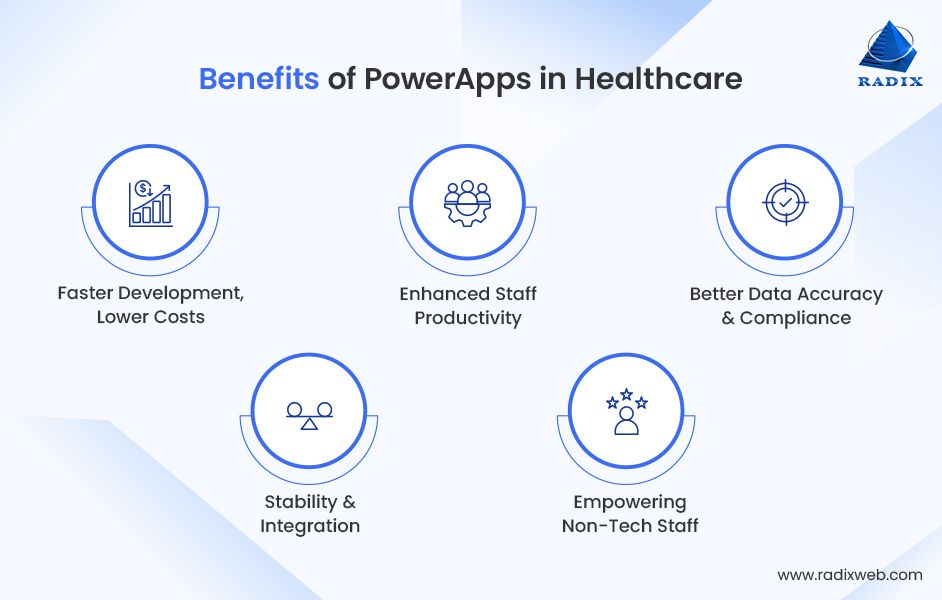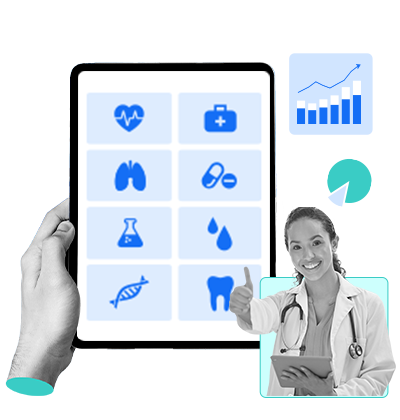Read More

Discover what’s next for AI in healthcare in 2026 - Get Access to the Full Report
ON THIS PAGE
Quick Overview: Let’s explore how PowerApps revolutionizes healthcare by enabling rapid, secure, and cost-effective development. From patient management to compliance, now is the time to discover key PowerApps use cases, benefits, and why PowerApps is the go-to solution for modern healthcare transformation.
From managing hospital data and patient records to streamlining staff coordination, the healthcare sector is experiencing a massive transformation, and Microsoft PowerApps is right at the center of it.
With the global healthcare IT market projected to reach $974.5 billion by 2027, the need for scalable, secure, and cost-effective digital solutions has never been greater. And while traditional software development methodologies take several months or even years to deliver expected outcomes, PowerApps flips the script in just a few days.
Microsoft PowerApps is emerging as a key catalyst, helping healthcare organizations overcome traditional limitations. Its low-code platform enables rapid application development. As a result, it empowers healthcare professionals to build, test, and deploy functional applications in weeks, not months.
Now the question comes – what does this look like in real-world healthcare scenarios?
Imagine a hospital ward where nurses spend less time on paperwork and can track bed availability in real-time via a mobile app, that too, without writing a single line of code. Or doctors can access real-time patient data with a single tap on a tablet. Or a vaccination center that uses a custom PowerApps to manage appointment scheduling, monitor vaccine stock, and reduce patient wait times.
You find these futuristic ideas, right? Well, they are not. They are already happening.
In fact, as per a Forrester report, organizations using Microsoft PowerApps saw around 188% ROI over three years with reduced development costs and improved operational efficiency.
So, now we know that PowerApps are being used across the healthcare industry for various purposes. And that’s what we are going to talk about in this blog post. We’ll explore the most impactful and innovative use cases of PowerApps in healthcare, backed by real-world examples, industry insights, and expert-driven best practices.
Whether you're a hospital admin, IT lead, or a healthcare startup, you’ll discover how low-code app development solutions can unlock high-impact outcomes.
Let’s read it now.
What is Microsoft PowerApps?
Microsoft PowerApps is a suite of applications, services, connectors, and a data platform that allows users to build custom business applications without extensive coding knowledge. It’s a low-code development platform empowering both developers and non-developers to create mobile-friendly, web-based apps that automate workflows and connect to various data sources, both on-premises and in the cloud.
PowerApps is a part of Microsoft Power Platform, which includes Power BI, Power Automate, SharePoint, and Power Virtual Agents.
How Do PowerApps Help in Healthcare Industry?
We all know that the healthcare industry deals with numerous sensitive information, from patient histories to staffing records. The majority of that data remains scattered across siloed systems, which makes it difficult to retrieve, interpret, or use effectively. The data often lacks the context or structure needed to drive meaningful action, even when accessed.
That’s where Microsoft Power Platform, particularly PowerApps, steps in. By centralizing data access and enabling custom app development, PowerApps empowers healthcare providers to turn scattered information into real-time, usable insights.
In fact, PowerApps app development helps organizations build scalable, cost-effective, and reliable applications. As a result, organizations can make decisions faster, reduce operational costs, and ultimately improve patient outcomes.
Transformative PowerApps Use Cases in Healthcare to Streamline Operations
The needs are rapidly changing with the way AI is transforming the healthcare industry. With in-depth research, we have identified a few effective Power Apps healthcare use cases that can connect to the daily activities of all the stakeholders. Let’s look into it.

Patient Intake and Registration Apps
Leave manual work like – clipboards and waiting room delays aside with patient intake and registration apps developed by PowerApps. Healthcare organizations are going for PoweApps healthcare solutions to create digital patient intake forms that help you store personal information, medical records, histories, and consent forms, directly on your tablet. With low-code backend platform integration, these apps reduce manual entry and minimize errors.
Appointment Scheduling and Management
Now, booking and managing appointments have become so much easier with Power Apps development. You can create custom apps that allow patients to book slots based on your availability, receive automated reminders, and complete pre-visit forms without visiting the premises.
In addition, staff can also manage doctor calendars and communicate with patients in a centralized dashboard. As a result, this leads to better time utilization, improved patient flow, and enhanced patient experience without having complex systems.
Remote Patient Monitoring Dashboards
Healthcare operations and patient care are automated and streamlined with PowerApps development. It makes it easy to track patients with chronic conditions or those recently discharged. Nurses can remotely keep track of patients’ data – blood pressure, glucose levels, or symptoms- and receive real-time alerts in case thresholds are crossed.
Moreover, you can easily integrate these dashboards with wearable devices or manual logs and push data securely into centralized systems. This reduces unnecessary paperwork and supports better long-term care plans.
Internal Staff Management and Shift Scheduling
Managing hospital staff across multiple departments is complex and can be challenging. However, Microsoft PowerApps for healthcare domain can automate and simplify it. You can easily build apps that allow doctors, nurses, and staff to view schedules, request time off, swap shifts, or log attendance. Internal approval workflows and notification make it easy for supervisors to maintain coverage while ensuring compliance with labor regulations.
Incident Reporting and Auditing Apps
We can't afford to even talk about loopholes or gaps in healthcare. Therefore, safety and compliance are more important aspects. Custom healthcare apps with PowerApps help staff to report incidents like medication errors, equipment failures, or workplace hazards on the go. It also comes with features, like uploading photos, automating routing to compliance offers, and auditing trails, helping organizations to maintain regulatory standards such as HIPAA or JCAHO.
Inventory and Asset Management
Keeping a database of equipment and supplies is essential for healthcare organizations. Therefore, healthcare solutions with PowerApps are available. These apps are used to track real-time status, location, and availability of assets like monitors, surgical kits, and other medical devices. Integration with barcode scanners and automated reorder alerts ensures nothing goes out of stock unexpectedly. PowerApps for healthcare asset tracking improves operational efficiency and reduces overhead costs.
Custom Clinical Decision Support Tools
Making critical decisions becomes much easier for clinicians. Building a custom medical app with PowerApps that provides real-time prompts, treatment protocols, and patient-specific recommendations based on input data.
For instance, an app could guide a nurse through triage steps or help a doctor evaluate drug interactions. These tools ensure consistency in care delivery, reduce load, and improve patient safety.
Benefits of PowerApps in Healthcare
In an industry where every resource and second matters, Microsoft Power Apps offers measurable benefits and ROI. These apps drive cost savings, operational improvements, and better patient outcomes.
Let’s read more about PowerApps healthcare benefits.

Faster Development, Lower Costs
Custom healthcare software development can take months to build and requires large IT infrastructure and budgets. Power Apps drastically cuts this down. With low code healthcare app development, PowerApps can be built in days or weeks. According to Forrester’s Total Economic Impact™ study, organizations using Power Apps achieved a 188% ROI over three years, thanks to reduced development time and outsourcing costs.
Enhanced Staff Productivity
Power Apps are the actual reason for freeing up valuable staff time, from healthcare workflow automation to streamlined approvals. In fact, a healthcare provider using Power Apps can save over 500 administrative hours annually. These time savings translate directly into improved focus on patient care and reduced burnout.
Better Data Accuracy and Compliance
Manual data entry is risky and prone to errors. Power Apps ensures real-time validation and automated syncing with databases like Microsoft Dataverse for cleaner, more compliant data. This not only reduces errors but also strengthens audit readiness and HIPAA compliance.
Scalability and Integration
You don’t have to replace existing systems to use Power Apps. PowerApps integration with EHR systems is possible and very easy. It can also be integrated with Microsoft 365, Dynamics 365, and other platforms without disrupting core operations.
Empowering Non-Tech Staff
One of the most powerful advantages of Power Apps is its ability to put technology directly into the hands of healthcare workers, even those with little or no coding experience. Instead of going with IT teams for every minor app request, non-tech users can also build, test, and deploy internal tools. It frees up IT teams to focus on large infrastructure projects.
Common Challenges in Healthcare App Development and How PowerApps Solves These Challenges
Let’s explore some of the most common challenges in healthcare app development and how PowerApps helps overcome them:
Long Development Cycles
The Challenge: Traditional app development in healthcare can take months due to complex requirements, testing cycles, and limited developer availability.
PowerApps Solution: You can reduce development time with PowerApps low-code and no-code app development. PowerApps allows non-developers to build and deploy apps with prebuilt templates and connectors in days or weeks.
High Development and Maintenance Costs
The Challenge: Custom app development requires large budgets for development, integration, and ongoing maintenance. It is not feasible for smaller clinics and public health organizations.
PowerApps Solution: You don’t need to have a huge budget to build PowerApps for healthcare. You can build it with in-house app developers. Updates and iterations are easy to manage without ongoing vendor reliance. This will reduce the cost of ownership while delivering a high ROI.
Regulatory Compliance and Data Security
The Challenge: Ensuring HIPAA compliance, data privacy, and secure access control is non-negotiable in healthcare apps.
PowerApps Solution: Built on Microsoft’s secure cloud infrastructure, PowerApps supports enterprise-grade security, role-based access controls, audit trails, and compliance standards like HIPAA, GDPR, and ISO.
Limited Staff Involvement
The Challenge: Most app development excludes the input of frontline healthcare workers. This results in tools that don’t align with real-world needs.
PowerApps Solution: PowerApps empowers non-technical users, including nurses, admin staff, and clinicians, to co-create solutions. This ensures that apps reflect real workflows, reduce inefficiencies, and improve usability across departments.
Why Choose Radixweb for PowerApps Healthcare Solutions?
When it comes to the healthcare industry, every decision you make directly impacts people’s lives. That’s why building Power Apps for healthcare digital transformation requires more than just technical knowledge; it demands domain expertise, a security-first mindset, and a user-centric approach. At Radixweb, we bring all that and more to the table with over 25 years of domain experience and expertise.
As a trusted Microsoft partner, we stand out as the go-to PowerApps development company for healthcare providers seeking scalable, secure, and HIPAA-compliant PowerApps.
Here’s why healthcare organizations choose Radixweb:
- Healthcare Domain Expertise
- Custom-Built PowerApps for Every Need
- Compliance-First Approach
- Faster Time to Market
- Global Delivery with a Personal Touch
- Team of Certified PowerApps Developers
Partnering with Radixweb means you’re getting a dedicated technology ally that understands your needs and goals in healthcare and delivers solutions that make a real difference.
Let’s connect and build better healthcare, together.
ConclusionPowerApps is reshaping and enabling healthcare workflow optimization. From improving patient care to streamlining operations, it empowers organizations to innovate quickly. With the right PowerApps development partner, your digital transformation journey becomes seamless and impactful.
Frequently Asked Questions
Are PowerApps secure enough for healthcare data?
Can PowerApps integrate with EHR systems like Epic or Cerner?
How quickly can a healthcare app be built with PowerApps?
Do I need coding knowledge to maintain PowerApps?
What are the costs involved in building a healthcare app using PowerApps?
How does PowerApps ensure data security and regulatory compliance (HIPAA, GDPR)?
Ready to brush up on something new? We've got more to read right this way.







